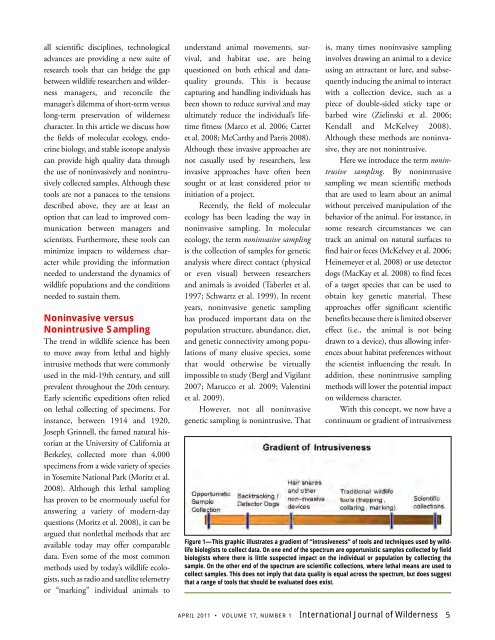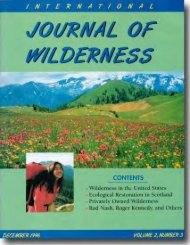Download April 2011 PDF - International Journal of Wilderness
Download April 2011 PDF - International Journal of Wilderness
Download April 2011 PDF - International Journal of Wilderness
Create successful ePaper yourself
Turn your PDF publications into a flip-book with our unique Google optimized e-Paper software.
all scientific disciplines, technological<br />
advances are providing a new suite <strong>of</strong><br />
research tools that can bridge the gap<br />
between wildlife researchers and wilderness<br />
managers, and reconcile the<br />
manager’s dilemma <strong>of</strong> short-term versus<br />
long-term preservation <strong>of</strong> wilderness<br />
character. In this article we discuss how<br />
the fields <strong>of</strong> molecular ecology, endocrine<br />
biology, and stable isotope analysis<br />
can provide high quality data through<br />
the use <strong>of</strong> noninvasively and nonintrusively<br />
collected samples. Although these<br />
tools are not a panacea to the tensions<br />
described above, they are at least an<br />
option that can lead to improved communication<br />
between managers and<br />
scientists. Furthermore, these tools can<br />
minimize impacts to wilderness character<br />
while providing the information<br />
needed to understand the dynamics <strong>of</strong><br />
wildlife populations and the conditions<br />
needed to sustain them.<br />
Noninvasive versus<br />
Nonintrusive Sampling<br />
The trend in wildlife science has been<br />
to move away from lethal and highly<br />
intrusive methods that were commonly<br />
used in the mid-19th century, and still<br />
prevalent throughout the 20th century.<br />
Early scientific expeditions <strong>of</strong>ten relied<br />
on lethal collecting <strong>of</strong> specimens. For<br />
instance, between 1914 and 1920,<br />
Joseph Grinnell, the famed natural historian<br />
at the University <strong>of</strong> California at<br />
Berkeley, collected more than 4,000<br />
specimens from a wide variety <strong>of</strong> species<br />
in Yosemite National Park (Moritz et al.<br />
2008). Although this lethal sampling<br />
has proven to be enormously useful for<br />
answering a variety <strong>of</strong> modern-day<br />
questions (Moritz et al. 2008), it can be<br />
argued that nonlethal methods that are<br />
available today may <strong>of</strong>fer comparable<br />
data. Even some <strong>of</strong> the most common<br />
methods used by today’s wildlife ecologists,<br />
such as radio and satellite telemetry<br />
or “marking” individual animals to<br />
understand animal movements, survival,<br />
and habitat use, are being<br />
questioned on both ethical and dataquality<br />
grounds. This is because<br />
capturing and handling individuals has<br />
been shown to reduce survival and may<br />
ultimately reduce the individual’s lifetime<br />
fitness (Marco et al. 2006; Cattet<br />
et al. 2008; McCarthy and Parris 2008).<br />
Although these invasive approaches are<br />
not casually used by researchers, less<br />
invasive approaches have <strong>of</strong>ten been<br />
sought or at least considered prior to<br />
initiation <strong>of</strong> a project.<br />
Recently, the field <strong>of</strong> molecular<br />
ecology has been leading the way in<br />
noninvasive sampling. In molecular<br />
ecology, the term noninvasive sampling<br />
is the collection <strong>of</strong> samples for genetic<br />
analysis where direct contact (physical<br />
or even visual) between researchers<br />
and animals is avoided (Taberlet et al.<br />
1997; Schwartz et al. 1999). In recent<br />
years, noninvasive genetic sampling<br />
has produced important data on the<br />
population structure, abundance, diet,<br />
and genetic connectivity among populations<br />
<strong>of</strong> many elusive species, some<br />
that would otherwise be virtually<br />
impossible to study (Bergl and Vigilant<br />
2007; Marucco et al. 2009; Valentini<br />
et al. 2009).<br />
However, not all noninvasive<br />
genetic sampling is nonintrusive. That<br />
is, many times noninvasive sampling<br />
involves drawing an animal to a device<br />
using an attractant or lure, and subsequently<br />
inducing the animal to interact<br />
with a collection device, such as a<br />
piece <strong>of</strong> double-sided sticky tape or<br />
barbed wire (Zielinski et al. 2006;<br />
Kendall and McKelvey 2008).<br />
Although these methods are noninvasive,<br />
they are not nonintrusive.<br />
Here we introduce the term nonintrusive<br />
sampling. By nonintrusive<br />
sampling we mean scientific methods<br />
that are used to learn about an animal<br />
without perceived manipulation <strong>of</strong> the<br />
behavior <strong>of</strong> the animal. For instance, in<br />
some research circumstances we can<br />
track an animal on natural surfaces to<br />
find hair or feces (McKelvey et al. 2006;<br />
Heinemeyer et al. 2008) or use detector<br />
dogs (MacKay et al. 2008) to find feces<br />
<strong>of</strong> a target species that can be used to<br />
obtain key genetic material. These<br />
approaches <strong>of</strong>fer significant scientific<br />
benefits because there is limited observer<br />
effect (i.e., the animal is not being<br />
drawn to a device), thus allowing inferences<br />
about habitat preferences without<br />
the scientist influencing the result. In<br />
addition, these nonintrusive sampling<br />
methods will lower the potential impact<br />
on wilderness character.<br />
With this concept, we now have a<br />
continuum or gradient <strong>of</strong> intrusiveness<br />
Figure 1—This graphic illustrates a gradient <strong>of</strong> “intrusiveness” <strong>of</strong> tools and techniques used by wildlife<br />
biologists to collect data. On one end <strong>of</strong> the spectrum are opportunistic samples collected by field<br />
biologists where there is little suspected impact on the individual or population by collecting the<br />
sample. On the other end <strong>of</strong> the spectrum are scientific collections, where lethal means are used to<br />
collect samples. This does not imply that data quality is equal across the spectrum, but does suggest<br />
that a range <strong>of</strong> tools that should be evaluated does exist.<br />
APRIL <strong>2011</strong> VOLUME 17, NUMBER 1 <strong>International</strong> <strong>Journal</strong> <strong>of</strong> <strong>Wilderness</strong> 5










